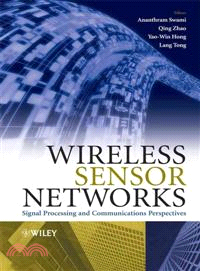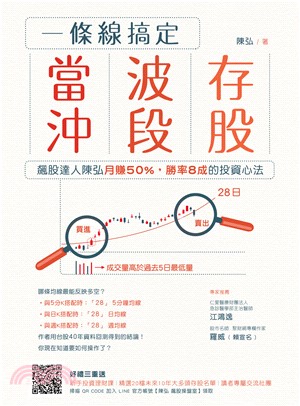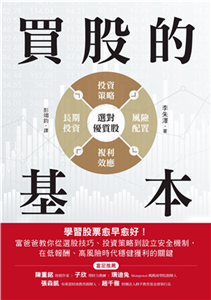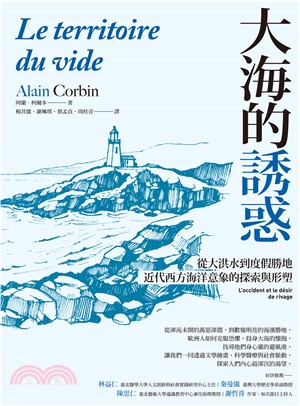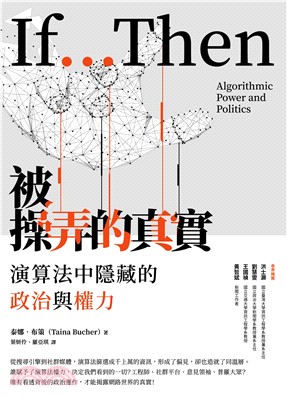Wireless Sensor Networks - Signal Processing And Communications Perspectives
商品資訊
ISBN13:9780470035573
出版社:John Wiley & Sons Inc
作者:Swami
出版日:2007/10/05
裝訂/頁數:精裝/416頁
定價
:NT$ 6078 元優惠價
:90 折 5470 元
若需訂購本書,請電洽客服 02-25006600[分機130、131]。
商品簡介
作者簡介
目次
相關商品
商品簡介
A wireless sensor network (WSN) uses a number of autonomous devices to cooperatively monitor physical or environmental conditions via a wireless network. Since its military beginnings as a means of battlefield surveillance, practical use of this technology has extended to a range of civilian applications including environmental monitoring, natural disaster prediction and relief, health monitoring and fire detection. Technological advancements, coupled with lowering costs, suggest that wireless sensor networks will have a significant impact on 21st century life.
The design of wireless sensor networks requires consideration for several disciplines such as distributed signal processing, communications and cross-layer design. Wireless Sensor Networks: Signal Processing and Communications focuses on the theoretical aspects of wireless sensor networks and offers readers signal processing and communication perspectives on the design of large-scale networks. It explains state-of-the-art design theories and techniques to readers and places emphasis on the fundamental properties of large-scale sensor networks.
Wireless Sensor Networks: Signal Processing and Communications :
Approaches WSNs from a new angle – distributed signal processing, communication algorithms and novel cross-layer design paradigms.
Applies ideas and illustrations from classical theory to an emerging field of WSN applications.
Presents important analytical tools for use in the design of application-specific WSNs.
Wireless Sensor Networks will be of use to signal processing and communications researchers and practitioners in applying classical theory to network design. It identifies research directions for senior undergraduate and graduate students and offers a rich bibliography for further reading and investigation.
The design of wireless sensor networks requires consideration for several disciplines such as distributed signal processing, communications and cross-layer design. Wireless Sensor Networks: Signal Processing and Communications focuses on the theoretical aspects of wireless sensor networks and offers readers signal processing and communication perspectives on the design of large-scale networks. It explains state-of-the-art design theories and techniques to readers and places emphasis on the fundamental properties of large-scale sensor networks.
Wireless Sensor Networks: Signal Processing and Communications :
Approaches WSNs from a new angle – distributed signal processing, communication algorithms and novel cross-layer design paradigms.
Applies ideas and illustrations from classical theory to an emerging field of WSN applications.
Presents important analytical tools for use in the design of application-specific WSNs.
Wireless Sensor Networks will be of use to signal processing and communications researchers and practitioners in applying classical theory to network design. It identifies research directions for senior undergraduate and graduate students and offers a rich bibliography for further reading and investigation.
作者簡介
Ananthram Swami, Army Research Laboratory, USA.
Qing Zhao, Assistant Professor, University of California, USA.
Yao-Win Hong, Assistant Professor, National Tsing hua University, Taiwan, ROC.
Lang Tong, Professor, Cornell University, USA.
Qing Zhao, Assistant Professor, University of California, USA.
Yao-Win Hong, Assistant Professor, National Tsing hua University, Taiwan, ROC.
Lang Tong, Professor, Cornell University, USA.
目次
List of Contributors.
1. Introduction.
Part I. Fundamental Properties and Limits.
2. Information-theoretic Bounds on Sensor Network Performance (Michael Gastpar).
2.1 Introduction.
2.2 Sensor Network Models.
2.2.1 The Linear Gaussian Sensor Network.
2.3 Digital Architectures.
2.3.1 Distributed Source Coding.
2.3.2 Distributed Channel Coding.
2.3.3 End-to-end Performance of Digital Architectures....
2.4 The Price of Digital Architectures.
2.5 Bounds on General Architectures.
2.6 Concluding Remarks and Some Interesting Questions.
Bibliography.
3 In-Network Information Processing in Wireless Sensor Networks (Arvind Giridhar and P. R. Kumar).
3.1 Introduction.
3.2 Communication Complexity Model.
3.3 Computing Functions Over Wireless Networks: Spatial Reuse and Block Computation .
3.3.1 Geographical Models of Wireless Communication Networks.
3.3.2 Block Computation and Computational Throughput.
3.3.3 Symmetric Functionsand Types.
3.3.4 The Collocated Network.
3.3.5 Subclasses of Symmetric Functions: Type-sensitive and Type-threshold.
3.3.6 Results on Maximum Throughput in Collocated Networks.
3.3.7 Multi-Hop Networks: The Random Planar Network.
3.3.8 Other Acyclic Networks.
3.4 Wireless Networks with Noisy Communications: Reliable Computation in a Collocated Broadcast Network.
3.4.1 The Sum of the Parity of the Measurements.
3.4.2 Threshold Functions.
3.5 Towards an Information Theoretic Formulation.
3.6 Conclusion.
Bibliography.
4 The Sensing Capacity of Sensor Networks (Rohit Negi, Yaron Rachlin, and Pradeep Khosla).
4.1 Introduction.
4.1.1 Large-Scale Detection Applications.
4.1.2 SensorNetworkas an Encoder.
4.1.3 Information Theory Context.
4.2 Sensing Capacity of Sensor Networks.
4.2.1 Sensor Network Model with Arbitrary Connections.
4.2.2 Random Coding and Method of Types.
4.2.3 Sensing Capacity Theorem.
4.2.4 Illustration of Sensing Capacity Bound.
4.3 Extensions to other Sensor Network Models.
4.3.1 Models with Localized Sensing.
4.3.2 Target Models.
4.4 Discussion and Open Problems.
Bibliography.
5. Law of Sensor Network Lifetime and Its Applications (Yunxia Chen and Qing Zhao).
5.1 Introduction.
5.2 Law of Network Lifetime and General Design Principle.
5.2.1 Network characteristics and lifetime definition.
5.2.2 Law of lifetime.
5.2.3 A general design principle for lifetime maximization.
5.3 Fundamental Performance Limit: A Stochastic Shortest Path Framework.
5.3.1 Problemstatement.
5.3.2 SSPformulation.
5.3.3 Fundamental performance limit on network lifetime.
5.3.4 Computing the limiting performance with polynomial complexity in network size.
5.4 Distributed Asymptotically Optimal Transmission Scheduling.
5.4.1 Dynamicprotocol for lifetimemaximization.
5.4.2 Dynamicnature of DPLM .
5.4.3 Asymptotic optimality of DPLM.
5.4.4 Distributedimplementation.
5.4.5 Simulation studies.
5.5 A Brief Overview of Network Lifetime Analysis.
5.6 Conclusion.
Bibliography.
Part II. Signal Processing for Sensor Networks.
6. Detection in Sensor Networks.
6.1 Centralized Detection.
6.2 The Classical Decentralized Detection Framework.
6.2.1 AsymptoticRegime.
6.3 Decentralized Detection in Wireless Sensor Networks.
6.3.1 Sensor Nodes.
6.3.2 Network Architectures...
6.3.3 Data Processing.
6.4 Wireless Sensor Networks.
6.4.1 Detection under Capacity Constraint.
6.4.2 Wireless Channel Considerations.
6.4.3 Correlated Observations.
6.4.4 Attenuation and Fading.
6.5 New Paradigms.
6.5.1 Constructive Interference.
6.5.2 Message Passing.
6.5.3 Cross-Layer Considerations.
6.5.4 Energy Savings via Censoringand Sleeping.
6.6 Extensions and Generalizations.
6.7 Discussion and Concluding Remarks.
Bibliography.
7. Distributed Estimation Under Bandwidth and Energy Constraints (Alejandro Ribeiro, Ioannis D. Schizas, Jin-Jun Xiao, Georgios B. Giannakis and Zhi-Quan Luo).
7.1 Distributed Quantization-Estimation.
7.2 Maximum Likelihood Estimation.
7.2.1 Known Noise pdf with Unknown Variance.
7.3 Unknown noise pdf.
7.3.1 Lower bound on the MSE.
7.4 Estimation of Vector parameters.
7.4.1 Colored Gaussian Noise.
7.5 Maximum a Posteriori Probability Estimation.
7.5.1 Mean-Squared Error.
7.6 Dimensionality Reduction for Distributed Estimation.
7.6.1 Decoupled Distributed Estimation-Compression.
7.6.2 Coupled Distributed Estimation-Compression.
7.7 Distortion-RateAnalysis.
7.7.1 Distortion-Rate for Centralized Estimation.
7.7.2 Distortion-RateforDistributedEstimation.
7.7.3 D-R Upper Bound via Convex Optimization.
7.8 Conclusion.
7.9 Further Reading.
Bibliography.
8. Distributed Learning in Wireless Sensor Networks (Joel B. Predd, Sanjeev R. Kulkarni, and H. Vincent Poor).
8.1 Introduction.
8.2 Classical Learning.
8.3 Distributed Learningin Wireless Sensor Networks.
8.3.1 A Genera lModel for Distributed Learning.
8.3.2 Related Work.
8.4 Distributed Learningin WSNs with a Fusion Center.
8.4.1 A Clustered Approach.
8.4.2 Statistical Limits of Distributed Learning.
8.5 Distributed Learningin Ad-hocWSNs with In-network Processing.
8.5.1 Message-passing Algorithms for Least-Squares Regression.
8.5.2 Other Work.
8.6 Conclusion.
Bibliography.
9. Graphical Models and Fusion in Sensor Networks (M¨ujdat C¸ etin, Lei Chen, John W. Fisher III, Alexander T. Ihler, O. Patrick Kreidl, Randolph L. Moses, Martin J. Wainwright, Jason L. Williams, and Alan S. Willsky).
9.1 Introduction.
9.2 Graphical Models.
9.2.1 Definitions and Properties.
9.2.2 Sum–Product Algorithms.
9.2.3 Max–Product Algorithms.
9.2.4 Loopy Belief Propagation.
9.2.5 Nonparametric Belief Propagation.
9.3 From Sensor Network Fusion to Graphical Models.
9.3.1 Self-Localization in Sensor Networks.
9.3.2 Multi-Object Data Association in Sensor Networks.
9.4 Message Censoring, Approximation,and Impacton Fusion.
9.4.1 Message Censoring.
9.4.2 Trading Off Accuracy for Bits in Particle-Based Messaging.
9.5 The Effects of Message Approximation .
9.6 Optimizing theUse of Constrained Resources in Network Fusion.
9.6.1 Resource management forobject trackingin sensor networks.
9.6.2 Distributed Inference with Severe Communication Constraints.
9.7 Conclusion.
Bibliography.
Part III. Communications, Networking and Cross-Layered Designs.
10. Randomized Cooperative Transmission in Large-Scale Sensor Networks (Birsen Sirkeci-Mergen and Anna Scaglione).
10.1 Introduction.
10.2 Transmit cooperation in sensor networks.
10.2.1 Physical Layer Model for Cooperative Radios.
10.2.2 Cooperative schemes with centralized code assignment.
10.3 Randomized distributed cooperative schemes.
10.3.1 Randomized code construction and system model.
10.4 Performance of Randomized Cooperative Codes.
10.4.1 Characterization of the Diversity Order.
10.4.2 Simulations and Numerical Evaluations.
10.5 Analysis of Cooperative Large-scale Networks utilizing Randomized Cooperative Codes.
10.5.1 Numerical Evaluations and Further Discussions.
10.6 Conclusion.
10.7 Appendix.
Bibliography.
11. Application Dependent Shortest Path Routing in Ad-Hoc Sensor Networks (Saswat Misra, Lang Tong, and Anthony Ephremides).
11.1 Introduction.
11.1.1 Major Classifications.
11.2 Fundamental SPR.
11.2.1 Broadcast Routing.
11.2.2 Static Shortest Path Routing.
11.2.3 Adaptive Shortest Path Routing.
11.2.4 Other Approaches.
11.3 SPR for MobileWireless Networks.
11.3.1 Broadcast Methods.
11.3.2 Shortest Path Routing.
11.3.3 Other Approaches.
11.4 SPRf or Ad-Hoc Sensor Networks.
11.4.1 A Short Survey of Current Protocols.
11.4.2 An Argument for Application Dependent Design.
11.4.3 Application Dependent SPR:An Illustrative Example.
11.5 Conclusion.
11.6 A Short Review of Basic Graph Theory.
11.6.1 Undirected Graph.s
11.6.2 DirectedGraphs.
Bibliography.
12. Data-Centric and CooperativeMAC Protocols for Sensor Networks (Yao-Win Hong and Pramod K. Varshney).
12.1 Introduction.
12.2 Traditional Medium Access Control Protocols: Random Access and Deterministic Scheduling.
12.2.1 Carrier Sense Multiple Access (CSMA) .
12.2.2 Time-Division Multiple Access (TDMA).
12.3 Energy Efficient MAC Protocols for Sensor Networks.
12.4 Data-Centric MAC Protocols for Sensor Networks.
12.4.1 Data Aggregation.
12.4.2 Distributed Source Coding.
12.4.3 Spatial Samplingof a Correlated Sensor Field.
12.5 Cooperative MAC Protocol for Independent Sources.
12.6 Cooperative MAC Protocol for Correlated Sensors.
12.6.1 Data Retrieval from Correlated Sensors.
12.6.2 Generalized Data-Centric Cooperative MAC.
12.6.3 MAC for Distributed Detection and Estimation.
12.7 DiscussionandFutureResearchDirections.
Bibliography.
13. Game Theoretic Activation and Transmission Scheduling in Unattended Ground Sensor Networks: A Correlated Equilibrium Approach (Vikram Krishnamurthy, Michael Maskery, and Minh Hanh Ngo).
13.1 Introduction.
13.1.1 UGSN Sensor Activation and Transmission Scheduling Methodology.
13.1.2 Fundamental Tools and Literature.
13.2 Unattended Ground Sensor Network: Capabilities and Objectives.
13.2.1 Practicalities: Sensor Network Model and Architecture.
13.2.2 Energy Efficient Sensor Activation and Transmission Control.
13.3 Sensor Activation as the Correlated Equilibrium of a Noncooperative Game.
13.3.1 From Nash to Correlated Equilibrium - An Overview.
13.3.2 Adaptive Sensor Activation through Regret Tracking.
13.3.3 Convergence Analysis of Regret-based Algorithms.
13.4 Energy Efficient Transmission Scheduling in UGSN - A Markov Decision Process Approach.
13.4.1 Outline of Markov Decision Processes and Supermodularity.
13.4.2 Optimal Channel-Aware Transmission Scheduling as a Markov Decision Process.
13.4.3 Optimality of Threshold Transmission Policies.
13.5 Numerical Results.
13.5.1 UGSN Sensor Activation Algorithm.
13.5.2 Energy Throughput Tradeoff via Optimal Transmission Scheduling.
13.6 Discussion and Extensions .
13.7 Appendix.
13.7.1 List of Symbols.
13.7.2 Proof of Lemma13.4.3.
13.7.3 Proof of Theorem13.4.4.
Bibliography.
Index.
1. Introduction.
Part I. Fundamental Properties and Limits.
2. Information-theoretic Bounds on Sensor Network Performance (Michael Gastpar).
2.1 Introduction.
2.2 Sensor Network Models.
2.2.1 The Linear Gaussian Sensor Network.
2.3 Digital Architectures.
2.3.1 Distributed Source Coding.
2.3.2 Distributed Channel Coding.
2.3.3 End-to-end Performance of Digital Architectures....
2.4 The Price of Digital Architectures.
2.5 Bounds on General Architectures.
2.6 Concluding Remarks and Some Interesting Questions.
Bibliography.
3 In-Network Information Processing in Wireless Sensor Networks (Arvind Giridhar and P. R. Kumar).
3.1 Introduction.
3.2 Communication Complexity Model.
3.3 Computing Functions Over Wireless Networks: Spatial Reuse and Block Computation .
3.3.1 Geographical Models of Wireless Communication Networks.
3.3.2 Block Computation and Computational Throughput.
3.3.3 Symmetric Functionsand Types.
3.3.4 The Collocated Network.
3.3.5 Subclasses of Symmetric Functions: Type-sensitive and Type-threshold.
3.3.6 Results on Maximum Throughput in Collocated Networks.
3.3.7 Multi-Hop Networks: The Random Planar Network.
3.3.8 Other Acyclic Networks.
3.4 Wireless Networks with Noisy Communications: Reliable Computation in a Collocated Broadcast Network.
3.4.1 The Sum of the Parity of the Measurements.
3.4.2 Threshold Functions.
3.5 Towards an Information Theoretic Formulation.
3.6 Conclusion.
Bibliography.
4 The Sensing Capacity of Sensor Networks (Rohit Negi, Yaron Rachlin, and Pradeep Khosla).
4.1 Introduction.
4.1.1 Large-Scale Detection Applications.
4.1.2 SensorNetworkas an Encoder.
4.1.3 Information Theory Context.
4.2 Sensing Capacity of Sensor Networks.
4.2.1 Sensor Network Model with Arbitrary Connections.
4.2.2 Random Coding and Method of Types.
4.2.3 Sensing Capacity Theorem.
4.2.4 Illustration of Sensing Capacity Bound.
4.3 Extensions to other Sensor Network Models.
4.3.1 Models with Localized Sensing.
4.3.2 Target Models.
4.4 Discussion and Open Problems.
Bibliography.
5. Law of Sensor Network Lifetime and Its Applications (Yunxia Chen and Qing Zhao).
5.1 Introduction.
5.2 Law of Network Lifetime and General Design Principle.
5.2.1 Network characteristics and lifetime definition.
5.2.2 Law of lifetime.
5.2.3 A general design principle for lifetime maximization.
5.3 Fundamental Performance Limit: A Stochastic Shortest Path Framework.
5.3.1 Problemstatement.
5.3.2 SSPformulation.
5.3.3 Fundamental performance limit on network lifetime.
5.3.4 Computing the limiting performance with polynomial complexity in network size.
5.4 Distributed Asymptotically Optimal Transmission Scheduling.
5.4.1 Dynamicprotocol for lifetimemaximization.
5.4.2 Dynamicnature of DPLM .
5.4.3 Asymptotic optimality of DPLM.
5.4.4 Distributedimplementation.
5.4.5 Simulation studies.
5.5 A Brief Overview of Network Lifetime Analysis.
5.6 Conclusion.
Bibliography.
Part II. Signal Processing for Sensor Networks.
6. Detection in Sensor Networks.
6.1 Centralized Detection.
6.2 The Classical Decentralized Detection Framework.
6.2.1 AsymptoticRegime.
6.3 Decentralized Detection in Wireless Sensor Networks.
6.3.1 Sensor Nodes.
6.3.2 Network Architectures...
6.3.3 Data Processing.
6.4 Wireless Sensor Networks.
6.4.1 Detection under Capacity Constraint.
6.4.2 Wireless Channel Considerations.
6.4.3 Correlated Observations.
6.4.4 Attenuation and Fading.
6.5 New Paradigms.
6.5.1 Constructive Interference.
6.5.2 Message Passing.
6.5.3 Cross-Layer Considerations.
6.5.4 Energy Savings via Censoringand Sleeping.
6.6 Extensions and Generalizations.
6.7 Discussion and Concluding Remarks.
Bibliography.
7. Distributed Estimation Under Bandwidth and Energy Constraints (Alejandro Ribeiro, Ioannis D. Schizas, Jin-Jun Xiao, Georgios B. Giannakis and Zhi-Quan Luo).
7.1 Distributed Quantization-Estimation.
7.2 Maximum Likelihood Estimation.
7.2.1 Known Noise pdf with Unknown Variance.
7.3 Unknown noise pdf.
7.3.1 Lower bound on the MSE.
7.4 Estimation of Vector parameters.
7.4.1 Colored Gaussian Noise.
7.5 Maximum a Posteriori Probability Estimation.
7.5.1 Mean-Squared Error.
7.6 Dimensionality Reduction for Distributed Estimation.
7.6.1 Decoupled Distributed Estimation-Compression.
7.6.2 Coupled Distributed Estimation-Compression.
7.7 Distortion-RateAnalysis.
7.7.1 Distortion-Rate for Centralized Estimation.
7.7.2 Distortion-RateforDistributedEstimation.
7.7.3 D-R Upper Bound via Convex Optimization.
7.8 Conclusion.
7.9 Further Reading.
Bibliography.
8. Distributed Learning in Wireless Sensor Networks (Joel B. Predd, Sanjeev R. Kulkarni, and H. Vincent Poor).
8.1 Introduction.
8.2 Classical Learning.
8.3 Distributed Learningin Wireless Sensor Networks.
8.3.1 A Genera lModel for Distributed Learning.
8.3.2 Related Work.
8.4 Distributed Learningin WSNs with a Fusion Center.
8.4.1 A Clustered Approach.
8.4.2 Statistical Limits of Distributed Learning.
8.5 Distributed Learningin Ad-hocWSNs with In-network Processing.
8.5.1 Message-passing Algorithms for Least-Squares Regression.
8.5.2 Other Work.
8.6 Conclusion.
Bibliography.
9. Graphical Models and Fusion in Sensor Networks (M¨ujdat C¸ etin, Lei Chen, John W. Fisher III, Alexander T. Ihler, O. Patrick Kreidl, Randolph L. Moses, Martin J. Wainwright, Jason L. Williams, and Alan S. Willsky).
9.1 Introduction.
9.2 Graphical Models.
9.2.1 Definitions and Properties.
9.2.2 Sum–Product Algorithms.
9.2.3 Max–Product Algorithms.
9.2.4 Loopy Belief Propagation.
9.2.5 Nonparametric Belief Propagation.
9.3 From Sensor Network Fusion to Graphical Models.
9.3.1 Self-Localization in Sensor Networks.
9.3.2 Multi-Object Data Association in Sensor Networks.
9.4 Message Censoring, Approximation,and Impacton Fusion.
9.4.1 Message Censoring.
9.4.2 Trading Off Accuracy for Bits in Particle-Based Messaging.
9.5 The Effects of Message Approximation .
9.6 Optimizing theUse of Constrained Resources in Network Fusion.
9.6.1 Resource management forobject trackingin sensor networks.
9.6.2 Distributed Inference with Severe Communication Constraints.
9.7 Conclusion.
Bibliography.
Part III. Communications, Networking and Cross-Layered Designs.
10. Randomized Cooperative Transmission in Large-Scale Sensor Networks (Birsen Sirkeci-Mergen and Anna Scaglione).
10.1 Introduction.
10.2 Transmit cooperation in sensor networks.
10.2.1 Physical Layer Model for Cooperative Radios.
10.2.2 Cooperative schemes with centralized code assignment.
10.3 Randomized distributed cooperative schemes.
10.3.1 Randomized code construction and system model.
10.4 Performance of Randomized Cooperative Codes.
10.4.1 Characterization of the Diversity Order.
10.4.2 Simulations and Numerical Evaluations.
10.5 Analysis of Cooperative Large-scale Networks utilizing Randomized Cooperative Codes.
10.5.1 Numerical Evaluations and Further Discussions.
10.6 Conclusion.
10.7 Appendix.
Bibliography.
11. Application Dependent Shortest Path Routing in Ad-Hoc Sensor Networks (Saswat Misra, Lang Tong, and Anthony Ephremides).
11.1 Introduction.
11.1.1 Major Classifications.
11.2 Fundamental SPR.
11.2.1 Broadcast Routing.
11.2.2 Static Shortest Path Routing.
11.2.3 Adaptive Shortest Path Routing.
11.2.4 Other Approaches.
11.3 SPR for MobileWireless Networks.
11.3.1 Broadcast Methods.
11.3.2 Shortest Path Routing.
11.3.3 Other Approaches.
11.4 SPRf or Ad-Hoc Sensor Networks.
11.4.1 A Short Survey of Current Protocols.
11.4.2 An Argument for Application Dependent Design.
11.4.3 Application Dependent SPR:An Illustrative Example.
11.5 Conclusion.
11.6 A Short Review of Basic Graph Theory.
11.6.1 Undirected Graph.s
11.6.2 DirectedGraphs.
Bibliography.
12. Data-Centric and CooperativeMAC Protocols for Sensor Networks (Yao-Win Hong and Pramod K. Varshney).
12.1 Introduction.
12.2 Traditional Medium Access Control Protocols: Random Access and Deterministic Scheduling.
12.2.1 Carrier Sense Multiple Access (CSMA) .
12.2.2 Time-Division Multiple Access (TDMA).
12.3 Energy Efficient MAC Protocols for Sensor Networks.
12.4 Data-Centric MAC Protocols for Sensor Networks.
12.4.1 Data Aggregation.
12.4.2 Distributed Source Coding.
12.4.3 Spatial Samplingof a Correlated Sensor Field.
12.5 Cooperative MAC Protocol for Independent Sources.
12.6 Cooperative MAC Protocol for Correlated Sensors.
12.6.1 Data Retrieval from Correlated Sensors.
12.6.2 Generalized Data-Centric Cooperative MAC.
12.6.3 MAC for Distributed Detection and Estimation.
12.7 DiscussionandFutureResearchDirections.
Bibliography.
13. Game Theoretic Activation and Transmission Scheduling in Unattended Ground Sensor Networks: A Correlated Equilibrium Approach (Vikram Krishnamurthy, Michael Maskery, and Minh Hanh Ngo).
13.1 Introduction.
13.1.1 UGSN Sensor Activation and Transmission Scheduling Methodology.
13.1.2 Fundamental Tools and Literature.
13.2 Unattended Ground Sensor Network: Capabilities and Objectives.
13.2.1 Practicalities: Sensor Network Model and Architecture.
13.2.2 Energy Efficient Sensor Activation and Transmission Control.
13.3 Sensor Activation as the Correlated Equilibrium of a Noncooperative Game.
13.3.1 From Nash to Correlated Equilibrium - An Overview.
13.3.2 Adaptive Sensor Activation through Regret Tracking.
13.3.3 Convergence Analysis of Regret-based Algorithms.
13.4 Energy Efficient Transmission Scheduling in UGSN - A Markov Decision Process Approach.
13.4.1 Outline of Markov Decision Processes and Supermodularity.
13.4.2 Optimal Channel-Aware Transmission Scheduling as a Markov Decision Process.
13.4.3 Optimality of Threshold Transmission Policies.
13.5 Numerical Results.
13.5.1 UGSN Sensor Activation Algorithm.
13.5.2 Energy Throughput Tradeoff via Optimal Transmission Scheduling.
13.6 Discussion and Extensions .
13.7 Appendix.
13.7.1 List of Symbols.
13.7.2 Proof of Lemma13.4.3.
13.7.3 Proof of Theorem13.4.4.
Bibliography.
Index.
主題書展
更多
主題書展
更多書展今日66折
您曾經瀏覽過的商品
購物須知
外文書商品之書封,為出版社提供之樣本。實際出貨商品,以出版社所提供之現有版本為主。部份書籍,因出版社供應狀況特殊,匯率將依實際狀況做調整。
無庫存之商品,在您完成訂單程序之後,將以空運的方式為你下單調貨。為了縮短等待的時間,建議您將外文書與其他商品分開下單,以獲得最快的取貨速度,平均調貨時間為1~2個月。
為了保護您的權益,「三民網路書店」提供會員七日商品鑑賞期(收到商品為起始日)。
若要辦理退貨,請在商品鑑賞期內寄回,且商品必須是全新狀態與完整包裝(商品、附件、發票、隨貨贈品等)否則恕不接受退貨。



